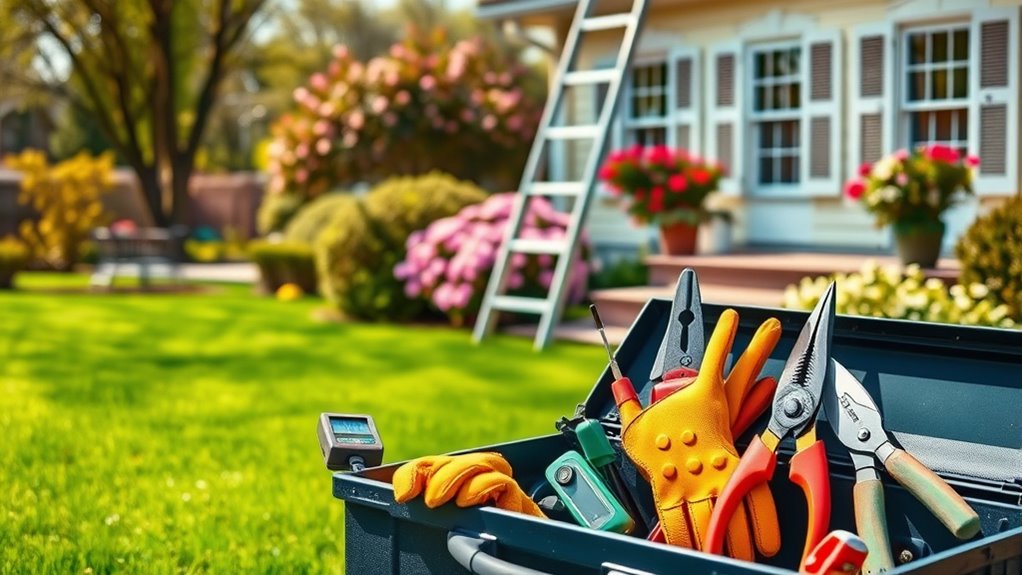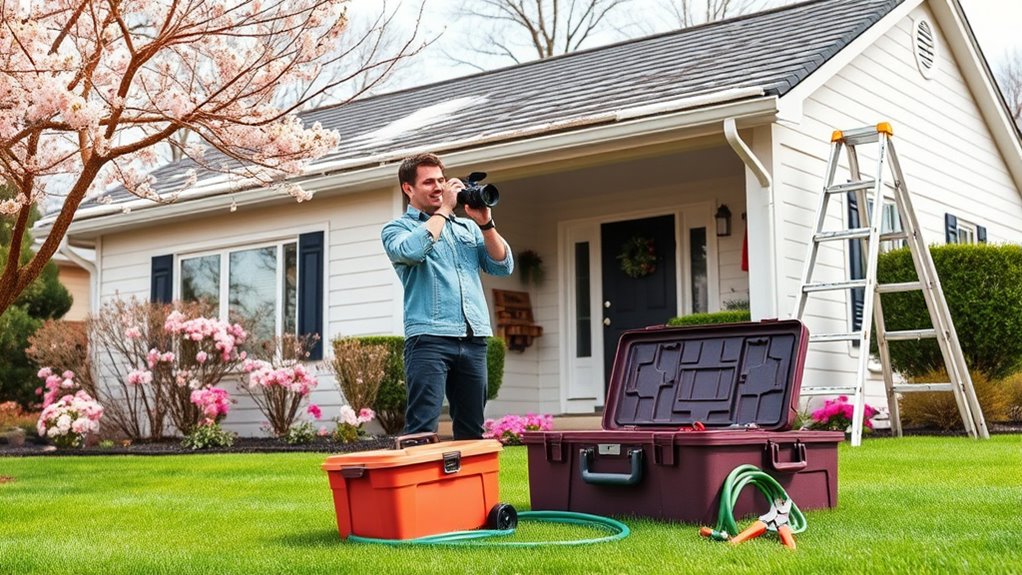Get your home spring-ready with this thorough maintenance checklist. Start by inspecting your HVAC system, replacing filters, and checking thermostats to ensure efficiency. Clean gutters, pressure wash exteriors, and repair cracks in walkways to prevent damage. Tune up lawn tools, prune trees, and remove debris around your home for safety. Inside, check for leaks, test detectors, and optimize insulation. For expert tips and detailed steps, keep exploring to make this season’s upkeep effortless.
Key Takeaways
- Perform HVAC system inspection, filter replacement, vent cleaning, and thermostat calibration for optimal indoor air quality.
- Clean gutters, pressure wash exterior surfaces, and seal windows and doors to prevent water damage and drafts.
- Tune up and inspect lawn equipment, check irrigation systems, and organize gardening tools for spring readiness.
- Prune trees and shrubs, clear brush, and mulch garden beds to promote healthy growth and reduce pest habitats.
- Conduct interior checks for moisture, leaks, smoke alarms, and foundation or roof damage to ensure a safe, well-maintained home.

Spring is the perfect time to tackle your home maintenance, ensuring everything runs smoothly after winter. This season offers an excellent opportunity to refresh your property, address potential issues, and prepare for the warmer months ahead. Start indoors by inspecting your HVAC system. Replacing air filters can considerably improve indoor air quality and make your system more efficient. Don’t forget to check your vents and registers for dust or blockages—cleaning these helps maintain good airflow. Schedule a professional tune-up for your HVAC units to guarantee they operate properly after the cold months. It’s also wise to verify your thermostat’s operation, recalibrating if necessary to save on energy costs. Additionally, assessing the bedroom environment can enhance your comfort and relaxation during the warmer months.
Moving outside, focus on your home’s exterior. Clear debris, leaves, and dirt from gutters and downspouts—clogged gutters can cause water damage and foundation problems. Pressure wash your decks, fences, and siding to remove mold, mildew, and grime that accumulated over winter. Inspect walkways, driveways, and patios for cracks; repairing these not only enhances your home’s appearance but also prevents safety hazards. Resealing wood surfaces such as decks and trim guards against moisture and sun damage, extending their lifespan. Additionally, assess and clean your exterior windows and door frames, re-caulking as needed to prevent drafts and water intrusion.
Don’t forget your lawn and garden tools. Tune up your mower and gardening equipment by sharpening blades and lubricating moving parts. Check your electric tools, ensuring batteries are charged and cords are in good shape to avoid safety issues. Store fuel and lubricants securely, away from flames, to prevent accidents. Organize your gardening tools and clean them thoroughly, preparing for the upcoming planting season. Inspect your irrigation system for leaks, broken sprinkler heads, or clogs to guarantee efficient watering once your garden starts to grow.
Tree and shrub care is also vital. Examine your trees for signs of damage, decay, or disease—hazards that could cause problems during storms. Remove dead or hazardous branches, preferably with professional help. Prune healthy trees and bushes to promote growth and keep them clear of utility wires. Clear brush around your home’s foundation and HVAC units to reduce pest habitats. Mulch garden beds and improve soil conditions to retain moisture and support healthy plants.
Lastly, conduct a thorough interior inspection. Check your basement and crawl spaces for moisture or leaks that could lead to mold. Test window and door seals, replacing worn weatherstripping to eliminate drafts. Ensure smoke alarms and CO detectors are functioning properly, replacing batteries or units if needed. Inspect plumbing fixtures for leaks or corrosion, and deep clean carpets and floors to remove winter dust and allergens. Examine your home’s foundation for cracks and inspect the roof for damaged shingles, addressing issues promptly. By following this extensive checklist, you’ll set your home up for a safe, efficient, and beautiful spring season.
Frequently Asked Questions
When Is the Best Time to Start Spring Maintenance?
You should start spring maintenance when the weather warms up and the risk of frost has passed. Aim for days when temperatures consistently stay above 40°F, ideally after the last frost date in your area. Early spring, around late March or early April, is perfect. Be flexible with your schedule, choosing clear, mild days to tackle outdoor projects first, then move indoors as needed.
How Often Should I Inspect My Roof in Spring?
You should inspect your roof at least once in spring, ideally twice—once after winter and again before summer. If your roof’s over 15 years old or shows signs like missing shingles, consider more frequent inspections. Severe weather or damage warrants additional checks. Regular inspections help catch issues early, prevent costly repairs, and keep your roof in good shape for the upcoming seasons. Always hire a professional for thorough, safe assessments.
Are There Eco-Friendly Spring Cleaning Options?
While harsh chemicals promise quick results, eco-friendly spring cleaning offers safer, sustainable solutions. You can use natural ingredients like vinegar, lemon juice, and baking soda to clean effectively without harming your family or the environment. Reusable microfiber cloths, DIY cleaners, and proper recycling make your routine greener. Choosing eco-friendly labels and reducing waste help protect nature, proving that cleaning can be powerful and environmentally responsible at the same time.
Do I Need Professional Help for HVAC Checks?
You might wonder if you need professional help for HVAC checks. The answer is yes, because technicians can identify hidden issues, improve energy efficiency, and extend your system’s lifespan. They use specialized tools and have the training to make sure everything runs safely and effectively. Regular professional maintenance also helps prevent costly breakdowns, improves indoor air quality, and keeps your system compliant with warranties and safety standards.
What Are Signs of Hidden Mold After Winter?
Did you know that over 50% of homes have hidden mold, often undetected? After winter, look for visible mold spores, dark spots on walls, or musty odors. You might also notice allergic reactions like itchy eyes or a stuffy nose, which can signal mold presence. Check behind drywall, under carpets, and inside ductwork. If you suspect hidden mold, consider professional testing to keep your home safe and healthy.
Conclusion
As you breathe new life into your home this spring, remember that a well-maintained house is your sanctuary’s heartbeat. Think of this checklist as your trusted map guiding you through renewal and renewal. By taking these simple steps, you’ll prevent small issues from blossoming into big problems, keeping your home running smoothly all season long. So roll up your sleeves—spring cleaning isn’t just about dirt, it’s about nurturing your haven to flourish with you.










